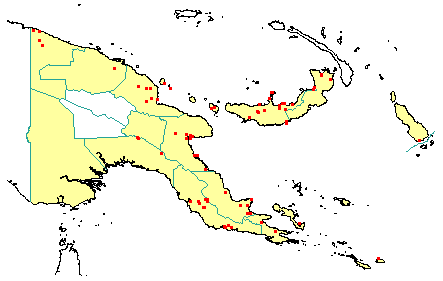
in PNGplants database
PNGTreesKey – Myristica globosa Warb. |
Barry Conn (NSW) & Kipiro Damas (LAE).
Guide to trees of Papua New Guinea
Copyright held by the authors, National Herbarium of New South Wales, and Papua New Guinea National Herbarium
Nova Acta Academiae Caesareae Leopoldino-Carolinae Germanicae Naturae Curiosorum. Abhandlungen der Kaiserlichen Leopoldinisch-Carolinischen Deutschen Akademie der Naturforscher Vol. 68: 540
Other Literature: W.J.J.O. De Wilde, Flora Malesiana, Series 1 480-483 (2000)
Family: Myristicaceae
Dicotyledon
Timber Group: Non-timber species
Field Characters: Large canopy tree (up to 30 m high) or Small sub-canopy tree; Bole cylindrical (mostly 40-70 cm diam.); straight (bole up to c. 5 m long); buttresses buttresses absent (sometimes slightly spurred near base); spines spines absent; aerial roots aerial roots absent; stilt roots sometimes stilt roots present or stilt roots absent; Bark brownish grey or brown, rough or almost smooth, slightly scaly or flaky or fissured; Subrhytidome (under-bark) red or brown; less than 25 mm thick, 5.0-8.0; bark blaze consisting of one layer; faintly to non-aromatic; pleasant; outer blaze pale pink, red, or brown, markings absent, fibrous; inner blaze pale pink, red, or brown, markings absent, fibrous; bark exudate (sap) present, colourless (watery), flowing or not readily flowing (spotty), colour changing on exposure to air, to red, not sticky or sticky; terminal buds not enclosed by leaves.
Indumentum: Complex hairs absent; stinging hairs absent; mature twig indumentum (hairs) present when young or absent, hairs sparse.
Leaves: Leaves spaced along branches, spiral (leaves occurring singly at a node and arranged spirally up the branchlet), simple (a leaf composed of a single blade); petiole present, not winged, attached to base of leaf blade, not swollen; leaves sometimes broadest below middle or equally broad throughout much of length, (6.0-) 7.0-16.0 (-21.0) cm, 2.0-7.0 (-8.0) cm; symmetric, entire, not dissected or lobed, acute or acuminate, venation pinnate, secondary veins open, prominent, intramarginal veins absent; leaves lower surface blue-green, pale green, or slightly grey, upper surface dark green (glossy) or slightly grey, indumentum (hairs) absent or present when young, indumentum (hairs) sparse; absent; domatia absent; stipules absent.
Flowers: Inflorescence axillary (and below leaves), flowers on a branched axis, cones absent; flowers unisexual, unisexual with male and female flowers on different plants, stalked, flowers with many planes of symmetry, 4.0-6.5 mm long, diameter small (up to10 mm diam.) (c. 3 mm diam.); perianth present, with all sepals and/or petals (hence tepals) similar, inner perianth cream-coloured, pale yellow, or green; 2-3, some or partly joined; stamens 10-?-16 (-20), absent, joined (to form a central staminal column), free of the perianth; ovary superior, carpels joined (when more than one), locules 1; styles absent.
Fruits: Infrutescence arising from single point (usually (usually 1-3 fruits per infructescence), fruit 15.0-32.0 (-40.0) mm long, 20.0 (c.) mm diam., yellow, red, or brown (with nut meg aroma), not spiny, fleshy, simple, dehiscent, capsule; seeds 1, much more than 10 mm long (10-22 mm long), not winged, narrow (longer than wide), seed more than 10 mm diam. (10-20 mm diam.).
Distribution: West Sepik, East Sepik, Madang, Morobe, Eastern Highlands, Western, Gulf, Central, Northern, Milne Bay, Papuan Islands, New Britain & Bougainville.
 | Botanical records in PNGplants database |
Notes: Notes WJ.J.O de Willde, 2000 (Flora Malesiana, Series 1, volume 14, pp. 482-483) recognises two subspecies, namely, subsp. globosa and subsp. chalmersii. The differences between these two subspecies appears to be slight with subsp. globosa having slightly larger fruit (at least 2.5 cm long), with pericarp 3-5 mm thick, whereas subsp. chalmersii has fruits up to 2.4 cm long and pericarp up to 3 mm thick.